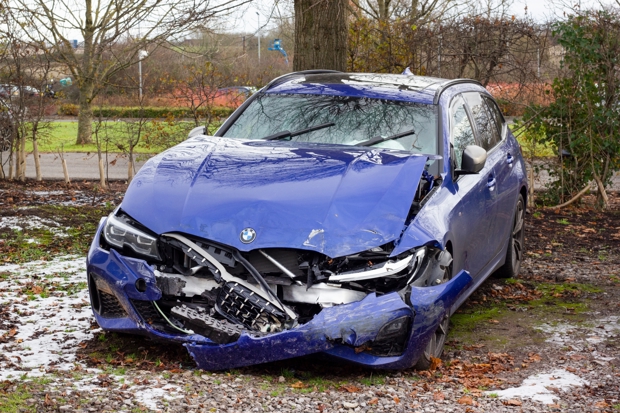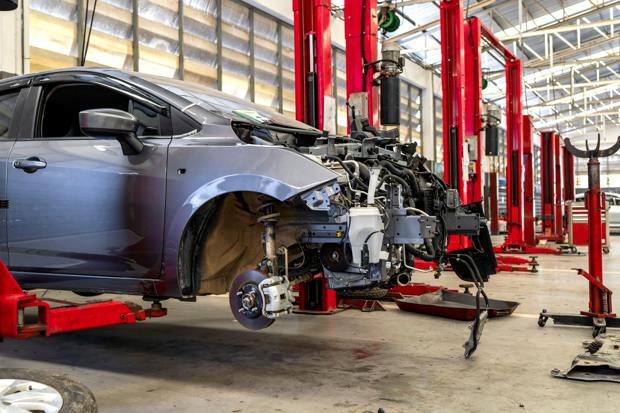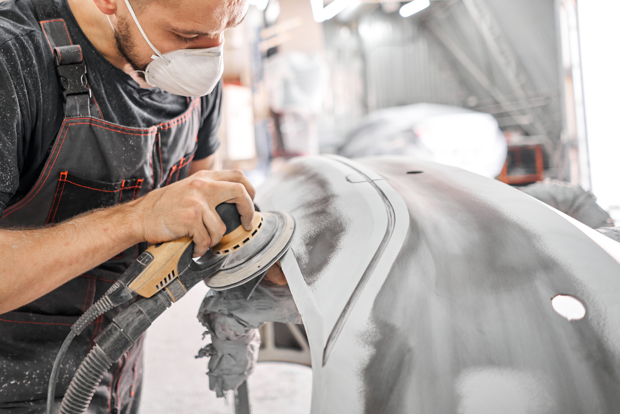What is a Cat S car?
Buying a used car? You may Cat S or Category S on a for sale advert. But what exactly is the Cat S meaning and should you avoid a Cat S car?

- Cat S meaning explained
- Can a Cat S car be repaired safely?
- Found out why you shouldn't buy a Cat S car
If you're buying a used car, chances are you will see cars listed as Cat S, Cat N or Cat C. They are usually much cheaper than those without.
A Category S (or Cat S) car is one that has suffered structural damage, but is still deemed to be repairable, albeit at greater expense than its market value and associated costs to the insurer.
If it is repaired, then the car’s salvage category is recorded on the V5C and remains with the vehicle for life, which reduces its appeal for many drivers and makes it worth less when it comes to sell it on.
However, it does mean there are some bargains about and skilled repairers will buy Category S cars from salvage auctions and fix them up. The key is understanding the condition and – critically - the quality of repairs.
You should bear in mind, too, that a write-off is based on a car’s value against the cost of fixing it – a car written off at 10 years old is likely to have sustained far less serious damage than one written-off at two years old, for example.
What does Cat S stand for?
The ‘S’ stands for structural’ This means that the car has been damaged beyond economical repair and has incurred some deformation to its main structure (generally speaking, the body shell, floors, chassis legs, roof or crossmembers).
Car been written off? Looking for a replacement?
If your car has been written off and you're looking to buy a replacement we can help. We list more than 60,000 new and used cars for sale priced from £1000 upwards covering everything from small runabouts to big SUVs.
What are the other insurance write-off categories?
Category A: Car may not be repaired and must be scrapped in its entirety.
Category B: Car may have its usable parts recycled, but it also must be crushed.
Category N: A write-off that has not sustained any damage to its structure, which may be repaired and safely returned to the road.

Is a Category S car worth buying?
Unlike buying a Cat N car, which has been deemed as not structurally damaged, a Cat S has been damaged in a way that would make it dangerous if not properly repaired.
Even if buying from a reputable dealer, you should be extremely vigilant and perform several checks to make sure it’s safe. At the very least, put the car through an MoT test at a garage independent from the dealer selling it.
The majority of issues that would make the car unsafe to drive would be identified during an MoT, so you’d hope that anything untoward would be flagged.
An independent vehicle inspection is also highly recommended to ensure the car is safe and you should only ever buy one that has been through the hands of a VBRA-approved repairer. The VBRA is the Vehicle Builders and Repairers Association.
Is a Cat S car cheaper than a non-write-off?
Category S cars are worth substantially less than unrecorded ones and are much harder to sell, so a repaired write-off isn’t necessarily a bargain – it depends what you plan to do with it and how long you want to keep it for.
While it may be cheaper to buy, it also has to be priced low to sell when you’re finished with it. That said, with cheaper cars that you wish to run into the ground it’s less of an issue – although Cat S is always a much bigger risk than a Cat N.
How do I know how badly a Cat S car was damaged?
There is no hard and fast way of knowing, but with Cat S the car has been structurally compromised and must have been repaired to a suitable standard by an authorised body repairer before being returned to the road.
Do not buy a Cat S car unless it comes with proof that repairs were carried out by a member of the Vehicle Body Repair Association (VBRA).
The date at which a car was written off is recorded on the V5C registration document and from that you’ll be able to work out how old it was when it was a total loss. If it was fairly new at the time, it’s likely to have sustained more severe damage than if it was an older model.
Will a Cat S classification affect the value of a car?
Yes, quite substantially. A Cat S car may look cheap, but it is cheap for a reason.
Once repaired, the salvage category is recorded on the V5C and remains with the car for life, which reduces its appeal for most buyers and makes it worth significantly less when it comes to sell it on, too.
Some skilled repairers will buy Category S cars from salvage auctions and fix them up. The key is understanding the condition of the car and the quality of repairs and being aware that it will always be worth a lot less than a car with no Cat S classification.
The categorisation will also largely reduce your chances of selling the car, as the majority of buyers will choose to avoid buying a Cat S car.

Is Cat S better than Cat N?
First, we need to consider all of the classifications. There are four categories of write-off: A, B, S and N. These replaced the old system that included Categories C and D.
A Category S vehicle is considered structurally compromised but possible to fix, while a Category N classification means the vehicle has no actual structural damage and is suitable for repair. As such, Cat S or Category S cars represent a greater risk and you need to be more cautious when buying one.
Category S means a car is still repairable by a qualified body specialist but has sustained damage to one or more parts of its main structure. Any structural part requiring realignment to its original dimensions or replacement. A car’s structure comprises the front bulkhead, front and side chassis rails, rear crossmembers, inner wings, wing supports, A and B-pillars and sills.
Is a Cat S car expensive to insure?
Insurers base their quotes on risk and a Category S car presents a higher risk than cars that are guaranteed to be structurally sound. It may be notably more expensive to insure, so if you must buy a Cat S car then you should factor this into the overall cost.
If you want to insure a Cat S car, it's worth getting quotes from the best rated insurance companies, which we've listed.
Will Cat S affect my insurance?
The Cat S categorisation will affect the cost of insurance and is likely to reduce the amount you can sell the car for in future, or claim for should it be damaged again.
Insurance is based on risk – and as the car has previously been classed as structurally damaged, this will be considered by the insurer when preparing your quote and it is likely to be higher than for a non-Cat S car.
Could I buy a Cat S car without realising it?
This is highly unlikely, but not impossible. The law is very strict on regulations for selling a Cat S car through the motor trade. Important information about its status cannot be concealed from you by a dealer – and that’s the law.
Check the paperwork thoroughly and if you have any suspicions, check its history with a vehicle information company such as HPI.
You’re at a much greater risk when buying privately, as although the Category S notification will be on the V5C registration document, the law doesn’t state that it must be in the advertisement. It is up to you as the buyer to check for this and a data check will always show if a car is listed as a Cat S.
It’s imperative that you carry out a data check on any privately purchased car, as your rights as a consumer are not as clearcut as when buying from a dealer.
What does ‘total loss’ mean in insurance terms?
When an insurer deems a car to be a ‘total loss’ it is essentially what you might know as an insurance write-off. The cost of repair and associated fees such as car hire, damages, recovery and admin fees is higher than the car’s resale value.
If the cost of any repair work is greater than half your vehicle’s total value, there’s a very good chance it will be written off, especially with older models. The additional costs of admin and hire car expenses often lead to insurers settling claims quickly.
Category S means a car has incurred damage deemed to be ‘structural’ by an insurer, but which can be safely repaired. A Cat S car will therefore be substantially less expensive than one that hasn’t been written off. A Cat S car can be safe, but you must exercise extreme caution.
Who repairs Cat S cars?
Most Cat S cars are sold via salvage auctions and are bought by independent body shops with the equipment required to repair them.
Because the cars cannot be sold for the same prices as those not recorded as write-offs, they can buy them for a lower price than undamaged cars. If you do wish to buy one, you should purchase from a registered repairer with the VBRA.
Category S cars are always acquired and resold by insurers to avoid them slipping through the net in private sales. They can be bought by independent repairers, but if you’re in the market for one it really only makes sense to buy one from a VBRA-approved source.
What is a car’s structure?
The car’s structure is defined by the Association of British Insurers (ABI) - one of the organisations behind the salvage code - and covers any structural part requiring realignment to its original dimensions or replacement.
A car’s structure comprises the front bulkhead, front and side chassis rails, rear crossmembers, inner wings, wing supports, A and B-pillars and sills.
Cat S cars have been independently determined to have incurred damage in these areas, so it’s imperative that any repairs are properly carried out, inspected and certified as such.
If you’re at all concerned about buying a Cat S car, then the best advice is not to.
